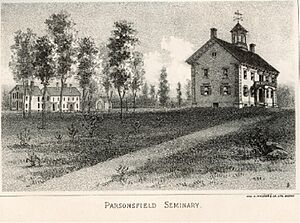Parsonsfield Seminary facts for kids
Quick facts for kids |
|
|
Parsonsfield Seminary
|
|
 |
|
| Location | Parsonsfield, Maine |
|---|---|
| Built | 1857 |
| Architectural style | Italianate |
| NRHP reference No. | 86001339 |
| Added to NRHP | June 20, 1986 |
The Parsonsfield Seminary was a famous school in North Parsonsfield, Maine. It was open from 1832 to 1949. This school was started by the Free Will Baptist church.
Today, you can still see its four old buildings. They are located on State Route 160, close to the New Hampshire border. This historic place is now listed on the National Register of Historic Places.
Contents
A School with a Special History
The Free Will Baptists were a religious group that started in the late 1700s. In 1832, a pastor named John Buzzell and other Free Baptists decided to open a school in Parsonsfield.
This school was like a high school. It was the very first Free Will Baptist school in the United States. In its first year, 140 students joined, both boys and girls! The first principal, Hosea Quimby, was very active in the Free Will Baptist community.
The school and its students became deeply involved in the abolitionist movement. This movement worked to end slavery. In the 1840s, the seminary even became a stop on the Underground Railroad. This was a secret network that helped people escape slavery and find freedom in Canada. While Oren B. Cheney was principal, students and supporters helped many people seeking freedom.
From 1840 to 1842, a special school for training ministers was also located at the seminary. It was called the Free Baptist Biblical School. Later, it became part of Bates College.
The Mysterious Fire
In 1853, something mysterious happened: Parsonsfield Seminary burned down at midnight. No one is completely sure what happened that night.
Oren Burbank Cheney, who was the principal, said that "the bell tower flickered in flames while the children ran from its pillar-brick walls." It was believed that three students and two people seeking freedom died in the fire. An investigation was started, but it didn't find clear answers.
Many people thought that those who were against the abolitionist movement might have caused the fire. However, this was never proven.
After the fire, Benjamin Bates, a supporter of the school, suggested a new plan. He told Cheney to sell the land in Parsonsfield, Maine. He wanted the school to be rebuilt in a new, larger location. So, in 1854, Cheney moved the main campus to Lewiston. This new school became a bigger Free Baptist school in a more central part of Maine.
Rebuilding and New Life
Even after the big fire, a smaller seminary building was rebuilt in Parsonsfield in 1857. It had a cupola (a small dome-like structure) and a weathervane on top.
Years later, in 1889, a rich businessman named Bartlett Doe helped the school. He was from Parsonsfield but lived in San Francisco. He bought the land and gave money to fix and improve Seminary Hall. He added a back wing and a front bell tower.
Bartlett Doe also paid for a new dormitory (a building where students live). A large addition was made to the dormitory in 1896. He also set up a fund of $100,000 to help the school financially.
Parsonsfield Seminary finally closed its doors in 1949. After that, the local school district used the buildings until 1986.
To protect this historic place, a group called the "Friends of the Parsonsfield Seminary" was formed. This group works to keep the beautiful Victorian buildings and grounds in good condition. They use the property for events like weddings, conferences, and graduations.
Notable People from Parsonsfield Seminary
- Oren B. Cheney: He was an abolitionist and the principal of Parsonsfield Seminary. He also founded Bates College.
- Person C. Cheney: He became a senator from New Hampshire.
- Samuel W. Gould: He served as a congressman.
- Lorenzo De Medici Sweat: He also became a congressman.




